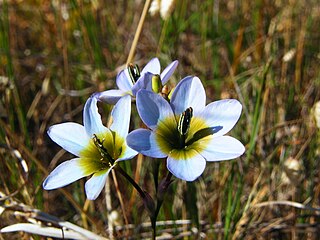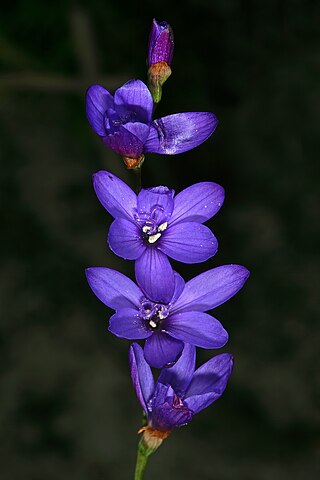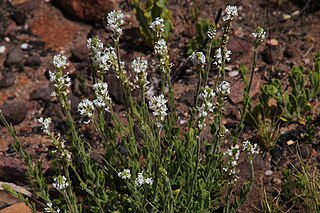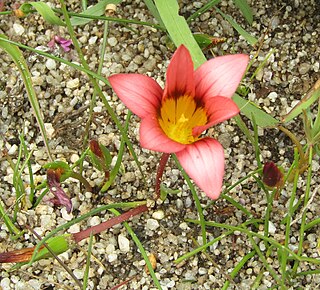
Isoetes, commonly known as the quillworts, is a genus of lycopod. It is the only living genus in the family Isoetaceae and order Isoetales. There are currently 192 recognized species, with a cosmopolitan distribution mostly in aquatic habitats but with the individual species often scarce to rare. Some botanists split the genus, separating two South American species into the genus Stylites, although molecular data place these species among other species of Isoetes, so that Stylites does not warrant taxonomic recognition. Species virtually identical to modern quillworts have existed since the Jurassic epoch, though the timing of the origin of modern Isoetes is subject to considerable uncertainty.

Isoetes lacustris, the lake quillwort or Merlin's grass, is a boreal quillwort native on both sides of the northern Atlantic Ocean. Synonyms include Isoetes hieroglyphica.
Isoetes eludens is an aquatic plant in the genus commonly known as quillwort that is native to the Kamiesberg Mountains in Namaqualand, South Africa. So far it is known to grow only in a single !gau (gnamma), a small temporary pool formed in a hollowed out area of granite rock. It has likely been growing in that region for millions of years, but was only discovered in 2007 and described in 2009. The specific epithet eludens refers to the fact that it eluded discovery, in spite of several searches in recent years in the area for new quillwort species.

Moraea aristata is a species of flowering plant in the family Iridaceae. It is referred to by the common names blue-eyed uintjie or Blouooguintjie in Afrikaans.It is endemic to the city of Cape Town and is considered to be critically endangered.

Baeometra is a genus in the family Colchicaceae containing a single species, Baeometra uniflora. It is native to South Africa, where it is commonly called beetle lily due to the dark markings on the tepals.

Gladiolus alatus is a species of geophyte from South Africa. Common names include painted ladies, king kalkoentjie and kipkippie. Kalkoentjie means "little turkey" in Afrikaans and refers to the shape of the flower, which resembles a turkey's wattle. It is popular as a garden plant and an important part of the cut flower industry in parts of the world on account of its large and showy orange flowers.

Ixia monadelpha, also known as the pied kalossie or bontkalossie, is an endangered species of geophyte found in wet sandy flats in the southwestern Cape of South Africa.
Isoetes toximontana, the Gifberg quillwort, is a plant species native to the Northern Cape and Western Cape regions of South Africa. It is known from only 3 sites. The type locality is on the slopes of Gifberg, a mountain forming part of the eastern boundary of the Olifants River Valley. The name "Gifberg" means "poison mountain"; this is in reference to a poisonous tree called "gifboom", Euphorbia virosa, that is endemic to the area. The specific epithet "toximontana" is a Latin translation of the Afrikaans name of the mountain.

Geissorhiza aspera, also known as the blue satin flower or blou sysie, is a geophyte from South Africa.

Isoetes echinospora, also known as spiny quillwort, spiny-spored quillwort or spring quillwort is a species of quillwort in the Isoetaceae family, and is the most abundant species in Canada. It can be found in shallow aquatic environments from Labrador and Newfoundland to Alaska, and south to Pennsylvania, Wisconsin, Michigan, Colorado, and California. In Germany it is found in only two locations: the Feldsee and Lake Titisee, both in the High Black Forest.
Lobostemon collinus, the pyjamabush or iron healthbush, is a species belonging to the forget me not family. It is known only from the fynbos biome of the Western Cape of South Africa.
Isoetes capensis, the cape quillwort, is a species of quillwort from South Africa.
Cheiridopsis schlechteri is a species of plant from South Africa. It is a succulent plant that grows in dry habitats.
Osmitopsis parvifolia is a species of plant from South Africa.

Hebenstretia lanceolata is a species of plant from South Africa. It belongs to the figwort family.

Romulea hirsuta is a geophyte from South Africa. It has pink flowers with dark marks at the edges of the yellow center.
Isoetes stephanseniae, the granite quillwort, is a species of quillwort from South Africa, named for A. J. Stephansen, who discovered it in 1927. Of very limited distribution, it is known to survive only as one population in seasonal pools over granite near Stellenbosch, where it is threatened by the encroachment of alien species and eutrophication from the sewage works on whose grounds it grows. Like other quillworts, it bears a tuft of leaves with distinctively sculpted megaspores. It is most similar to Isoetes capensis, the cape quillwort, which occurs in the same province; both hold their leaves at a 45-degree angle, unlike most South African quillworts which have leaves stiffly erect.

Lachenalia unifolia, the banded viooltjie, is the most common Lachenalia species in the Cape Floristic Region of South Africa.
Lachenalia variegata, also known as the spotty viooltjie, is a species of plant from the Western Cape of South Africa.










